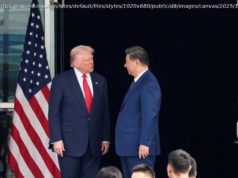Beijing says U. S. guided missile destroyer " trespassed" near islands over which it claims " indisputable sovereignty"
Chinese dredging vessels are purportedly seen in the waters around Mischief Reef in the disputed Spratly Islands in the South China Sea in this still image from video taken by a P-8A Poseidon surveillance aircraft provided by the United States Navy in this May 21,2015 file photo.
BEIJING — China protested a U. S. Navy patrol that sent a guided missile destroyer near a group of man-made islands in the South China Sea on Thursday, in the first American challenge to Beijing’s claims to the waters since President Trump took office.
China ’s Defense Ministry told reporters that it had sought an explanation with U. S. officials over the incident, which involved the USS Dewey and took place around Mischief Reef, one of a chain of artificial islands China has built and fortified to assert its claims over the strategic waterway.
President-elect Donald Trump has not gotten off on the right foot with China thanks to his phone call with the leader of Taiwan. Mark Leibovich, …
The Dewey came within six miles of the reef, U. S. defense officials have confirmed to CBS News. A Chinese frigate shadowed the American warship during its passage, and two other Chinese vessels were in vicinity.
CBS News national security correspondent David Martin reports the Dewey was challenged 23 times by the Chinese vessel over the radio. The Dewey’s crew responded with standard language identifying their vessel, and stating that it was operating in international waters.
Washington has in the past insisted that it has the right to conduct so-called freedom of navigation operations, or FONOPS, in the area because it is in international waters. The Navy conducted similar operations under former President Obama, but had not done so since Mr. Trump took office and began talking up the prospect of warming ties with Beijing and cooperating over issues like North Korea.
A spokesman for the Chinese Foreign Ministry said the U. S. destroyer had „trespassed“ near islands over which China has „indisputable sovereignty.“
CBS News correspondent Seth Doane takes a look at China’s increased building of islands in the disputed terrirtory of the South China Sea.
„We urge the U. S. to correct this mistake and stop taking further actions so as to avoid hurting peace and security in the region and long-term cooperation between the two countries, “ Foreign Ministry spokesman Lu Kang said.
Defense Ministry spokesman Col. Ren Guoqiang told reporters at a monthly news briefing that a pair of Chinese navy frigates had warned off the American ship after it entered the area without China’s permission.
„We urge the American side to take concrete efforts to correct its wrongdoings and add more positive energy to the military-to-military relationship, “ Ren said.
The spokesman added that the U. S. actions not only posed the risk of sparking an accident at sea but would „only motivate the Chinese military to enhance its capacity.“
Go behind the scenes with Seth Doane as he and his team try to find out what China is really up to on disputed islands in the South China Sea.
China claims virtually the entire South China Sea and has aggressively tried to fortify its foothold in recent years by transforming seven mostly submerged reefs into island outposts, some with runways and radars and — more recently — weapons systems .
The work is opposed by the other claimants to the atolls and the United States, which are wary of restrictions on ship movements in a key waterway for world trade which boasts rich fishing grounds and a potential wealth of undersea oil, gas and mineral deposits. An international tribunal last year rejected most of China’s claims to the waters and said its land reclamation was aggravating tensions and violating the sovereignty of fellow claimant the Philippines. China has ignored the ruling.
China contends the man-made islands are primarily for civilian purposes and to increase safety for ships. It has said it won’t interfere with freedom of navigation or overflight, but there have been questions about whether that includes military ships and aircraft.
A bipartisan group of U. S. senators earlier this month urged Trump to resume freedom of navigation operations that had last been conducted in October. The senators described the South China Sea as critical to U. S. national security interests and to peace in the Asia-Pacific.
U. S. Defense Department spokesman Maj. Jamie Davis said in an emailed statement that U. S. forces in the Asia-Pacific region would continue to conduct freedom of navigation operations to „challenge excessive maritime claims in order to preserve the rights, freedoms, and uses of the sea and airspace guaranteed to all nations under international law.“
Davis gave no details of Thursday’s operation, saying summaries would only be released in an annual report and adding that U. S. forces conducted such operations last year to challenge claims by 22 coastal states, including allies and partners.
„U. S. forces operate in the Asia-Pacific region on a daily basis, including in the South China Sea. All operations are conducted in accordance with international law and demonstrate that the United States will fly, sail, and operate wherever international law allows, “ Davis said.
„FONOPS are not about any one country, nor are they about making political statements.“
Jonathan Starr tells „60 Minutes“ that when he founded a school in struggling Somaliland, he gave students a “chance to win” and that’s exactly what they did
Allegations of stolen children, drugs, abuse and a leader who claimed to be the second coming of Jesus Christ — „48 Hours“ follows the trail of a cult that began in Australia and led the FBI to New York






